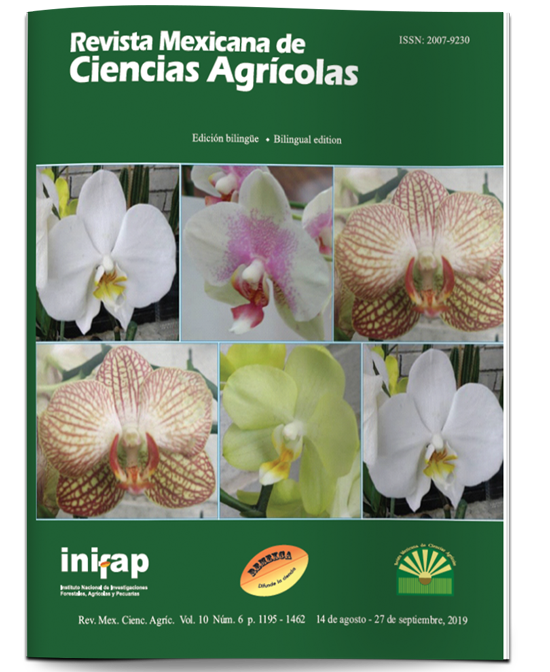Red spider in jackfruit: bioecology and biological efficacy of acaricides
DOI:
https://doi.org/10.29312/remexca.v10i6.1825Keywords:
Tetranychus pacificus Lam. (Moraceae), mites, control, jackfruitAbstract
Jackfruit (Artocarpus heterophyllus) has become an important fruit and represents a production option for tropical areas of Mexico. However, due to its recent introduction, information on its associated pests and diseases and management recommendations is still limited. In 2017, deformation of the leaves, discoloration of the beam and the presence of spider webs on the underside caused by an unknown mite were observed. The objective of this research was to identify the associated mite, determine its population distribution and fluctuation and evaluate the biological efficacy of acaricides. The study was conducted during 2018-2019 in Nayarit, Mexico. The identified mite is Tetranychus pacificus known as the red spider. It is distributed in all producing areas of jackfruit in Nayarit. It was mainly detected from November to June with greater infestation in the Tecuitata producing area (0.86 mites’ leaf-1) and Jalcocotan (0.57 mites’ leaf-1) of the municipality of San Blas. On average in September and October its presence is imperceptible; however, in El Capomo only in July was detected which probably indicates an initial stage of dispersal of the mite. Significant correlation was observed (β= 0.0489, r= -0.73, F= 0.0345, α= 0.05) of the population with the temperature, with a decrease in the population at a higher temperature and accentuated from 26 ° C. No correlation was observed with relative humidity. The highest temperature (27.9 °C) and relative humidity (88.2%) occurred in the month of July and September, respectively, months in which the lowest mite population was observed. The acaricides evaluated exercised significant control. At 21 days after application, differences occurred between treatments and the absolute control (Pr>F= 0.0245). With the application of azadirachtin (1.9 g of ia L-1 of water) and mineral oil (16.9 g of ia L-1 of water) a control of 75.9% and 72.5%, respectively, was obtained.
Downloads
Downloads
Published
How to Cite
Issue
Section
License
The authors who publish in Revista Mexicana de Ciencias Agrícolas accept the following conditions:
In accordance with copyright laws, Revista Mexicana de Ciencias Agrícolas recognizes and respects the authors’ moral right and ownership of property rights which will be transferred to the journal for dissemination in open access. Invariably, all the authors have to sign a letter of transfer of property rights and of originality of the article to Instituto Nacional de Investigaciones Forestales, Agrícolas y Pecuarias (INIFAP) [National Institute of Forestry, Agricultural and Livestock Research]. The author(s) must pay a fee for the reception of articles before proceeding to editorial review.
All the texts published by Revista Mexicana de Ciencias Agrícolas —with no exception— are distributed under a Creative Commons License Attribution-NonCommercial 4.0 International (CC BY-NC 4.0), which allows third parties to use the publication as long as the work’s authorship and its first publication in this journal are mentioned.
The author(s) can enter into independent and additional contractual agreements for the nonexclusive distribution of the version of the article published in Revista Mexicana de Ciencias Agrícolas (for example include it into an institutional repository or publish it in a book) as long as it is clearly and explicitly indicated that the work was published for the first time in Revista Mexicana de Ciencias Agrícolas.
For all the above, the authors shall send the Letter-transfer of Property Rights for the first publication duly filled in and signed by the author(s). This form must be sent as a PDF file to: revista_atm@yahoo.com.mx; cienciasagricola@inifap.gob.mx; remexca2017@gmail.
This work is licensed under a Creative Commons Attribution-Noncommercial 4.0 International license.



